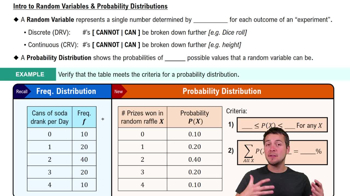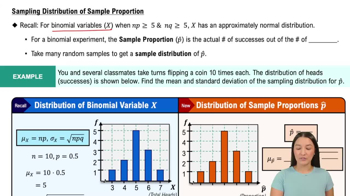Notation The author conducted an experiment in which the height of each student was measured in centimeters and those heights were matched with the same students’ scores on the first statistics test. If we find that r = 0, does that indicate that there is no association between those two variables?
Table of contents
- 1. Intro to Stats and Collecting Data1h 14m
- 2. Describing Data with Tables and Graphs1h 55m
- 3. Describing Data Numerically2h 5m
- 4. Probability2h 16m
- 5. Binomial Distribution & Discrete Random Variables3h 6m
- 6. Normal Distribution and Continuous Random Variables2h 11m
- 7. Sampling Distributions & Confidence Intervals: Mean3h 23m
- Sampling Distribution of the Sample Mean and Central Limit Theorem19m
- Distribution of Sample Mean - Excel23m
- Introduction to Confidence Intervals15m
- Confidence Intervals for Population Mean1h 18m
- Determining the Minimum Sample Size Required12m
- Finding Probabilities and T Critical Values - Excel28m
- Confidence Intervals for Population Means - Excel25m
- 8. Sampling Distributions & Confidence Intervals: Proportion1h 25m
- 9. Hypothesis Testing for One Sample3h 29m
- 10. Hypothesis Testing for Two Samples4h 50m
- Two Proportions1h 13m
- Two Proportions Hypothesis Test - Excel28m
- Two Means - Unknown, Unequal Variance1h 3m
- Two Means - Unknown Variances Hypothesis Test - Excel12m
- Two Means - Unknown, Equal Variance15m
- Two Means - Unknown, Equal Variances Hypothesis Test - Excel9m
- Two Means - Known Variance12m
- Two Means - Sigma Known Hypothesis Test - Excel21m
- Two Means - Matched Pairs (Dependent Samples)42m
- Matched Pairs Hypothesis Test - Excel12m
- 11. Correlation1h 6m
- 12. Regression1h 50m
- 13. Chi-Square Tests & Goodness of Fit1h 57m
- 14. ANOVA1h 57m
1. Intro to Stats and Collecting Data
Intro to Stats
Problem 10.2.29
Textbook Question
Large Data Sets
Exercises 29–32 use the same Appendix B data sets as Exercises 29–32 in Section 10-1. In each case, find the regression equation, letting the first variable be the predictor (x) variable. Find the indicated predicted values following the prediction procedure summarized in Figure 10-5.
Taxis Repeat Exercise 15 using all of the time/tip data from the 703 taxi rides listed in Data Set 32 “Taxis” from Appendix B.
 Verified step by step guidance
Verified step by step guidance1
Step 1: Understand the problem. You are tasked with finding the regression equation using the time/tip data from 703 taxi rides. The regression equation is typically of the form y = mx + b, where y is the dependent variable (tip), x is the independent variable (time), m is the slope, and b is the y-intercept.
Step 2: Organize the data. Extract the time (predictor variable, x) and tip (response variable, y) data from Data Set 32 'Taxis' in Appendix B. Ensure the data is clean and free of missing or erroneous values.
Step 3: Calculate the necessary statistics. Compute the mean and standard deviation for both the x (time) and y (tip) variables. Also, calculate the covariance between x and y, and the variance of x. These values are essential for determining the slope (m) and intercept (b) of the regression equation.
Step 4: Derive the regression equation. Use the formulas: m = Cov(x, y) / Var(x) for the slope, and b = ȳ - m * x̄ for the intercept, where x̄ and ȳ are the means of x and y, respectively. Substitute the calculated values into these formulas to obtain the regression equation.
Step 5: Predict the indicated values. Using the regression equation obtained in Step 4, substitute the given x-values (time) into the equation to calculate the predicted y-values (tips). Follow the prediction procedure summarized in Figure 10-5 to ensure accuracy.
 Verified video answer for a similar problem:
Verified video answer for a similar problem:This video solution was recommended by our tutors as helpful for the problem above
Video duration:
11mPlay a video:
Was this helpful?
Key Concepts
Here are the essential concepts you must grasp in order to answer the question correctly.
Regression Analysis
Regression analysis is a statistical method used to model the relationship between a dependent variable and one or more independent variables. In this context, the regression equation helps predict the value of the dependent variable based on the predictor variable. Understanding how to derive and interpret the regression equation is crucial for making accurate predictions from the data.
Predictor and Response Variables
In regression analysis, the predictor variable (independent variable) is the one used to predict the outcome of the response variable (dependent variable). Identifying which variable serves as the predictor is essential for setting up the regression model correctly. In the given question, the first variable is designated as the predictor, which influences the predicted values of the response variable.
Recommended video:
Guided course

Intro to Random Variables & Probability Distributions
Data Sets and Sample Size
A data set is a collection of related data points, and the sample size refers to the number of observations in that data set. In this exercise, the data set consists of time/tip data from 703 taxi rides, which provides a substantial sample size for analysis. A larger sample size generally leads to more reliable and valid statistical conclusions, making it important to consider when performing regression analysis.
Recommended video:

Sampling Distribution of Sample Proportion

 2:13m
2:13mWatch next
Master Introduction to Statistics Channel with a bite sized video explanation from Patrick
Start learningRelated Videos
Related Practice
Textbook Question
